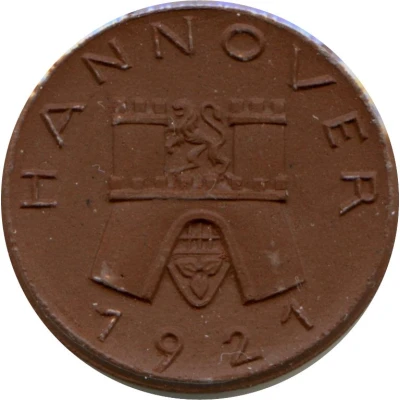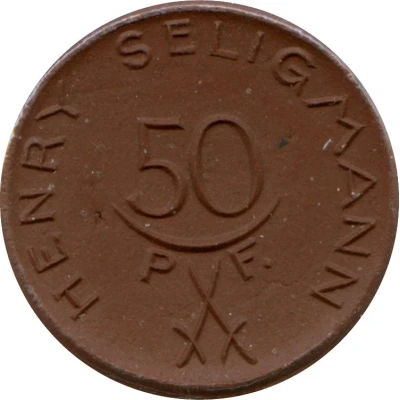


© tolnomur (CC BY-NC-SA)
50 Pfennigs - Hannover Henry Seligmann
1921 year| Porcelain (brown) | 3.3 g | 25 mm |
| Issuer | City of Hanover (notgeld) (Prussian province of Hanover) |
|---|---|
| Period | Weimar Republic (1918-1933) |
| Type | Standard circulation coin |
| Year | 1921 |
| Value | 50 Pfennigs (50 Pfennige) (0.50) |
| Currency | Mark (1914-1924) |
| Composition | Porcelain (brown) |
| Weight | 3.3 g |
| Diameter | 25 mm |
| Shape | Round |
| Technique | Milled |
| Orientation | Medal alignment ↑↑ |
| Demonetized | Yes |
| Updated | 2024-10-04 |
| Numista | N#135102 |
|---|---|
| Rarity index | 83% |
Reverse
Script: Latin
Lettering:
Henry Seligmann
50 PF
Comment
Menzel: EEESeligmann made from 1896 to 1903 in Hamburg a banking apprenticeship at the operating in the banking and exchange business company Flörsheim, which also acted with coins. He then became managing director of the bank and lottery business NM Falck & Co. in Hanover. In 1905 he took over the company and ran his own bank and lottery business under the name Henry Seligmann, bank lottery and coin business , first in the Bahnhofstrasse 1, since 1907 in the Contihaus in the Georgstraße 20. In addition to the sale of lottery tickets and the money moved Seligmann business more on the coin trade and under the name coin business Henry Seligmann , the company soon became one of the most important coin dealers in northern Germany until 1933 numerous auctions carried out, including the collection Karl Graf Inn and Knyphausen from the possession of the Provincial Museum Hannover (catalogs edited by Georg Pfanneberg). In 1921, he issued as emergency money two porcelain coins to 25 and 50 Pfennig out. 1927 to 1928 he moved the magazine Sammelfreunden. Magazine for all collecting areas , 1928-1930 the magazine Hannoverscher Münzverkehr . Wikipedia
Interesting fact
One interesting fact about this coin is that it was made of porcelain, which is a unique material for coins. Porcelain is a type of ceramic material that is known for its durability and resistance to wear and tear, making it an unusual choice for a coin that was intended to be used in circulation. The use of porcelain for this coin may have been a deliberate choice to create a distinctive and memorable design, or it may have been a practical decision due to the limited availability of other materials at the time. Regardless of the reason, the use of porcelain gives this coin a distinctive look and feel that sets it apart from other coins.
Price
| Date | Mintage | VG | F | VF | XF | AU | UNC |
|---|---|---|---|---|---|---|---|
| 1921 | 12000 | - | - | - | - | - | - |
Values in the table are based on evaluations by sales realized on Internet platforms. They serve as an indication only for 50 Pfennigs - Hannover (Henry Seligmann) 1921 coin.